Caterpillar Chronicles: Unveiling the Art of Preserving Lepidopteran Larvae
- EdTomologist
- Junior Member

- Reactions:
- Posts: 67
- Joined: Wed May 17, 2023 5:29 pm
- Contact:

 Caterpillar Chronicles: Unveiling the Art of Preserving Lepidopteran Larvae
Caterpillar Chronicles: Unveiling the Art of Preserving Lepidopteran Larvae
Today, I want to dive into a captivating topic that often gets overlooked in our beloved world of lepidopterans: caterpillar preservation. As avid lepidopterists, we tend to focus our collections on the stunning imago, the pinnacle of metamorphosis. However, the life cycle of these fascinating creatures is so much more than just the winged beauty that graces our nets.
When it comes to caterpillars, they often get the short end of the preservation stick. They're a tricky bunch to preserve and they don't always possess the same aesthetic appeal as their adult counterparts. I, for one, am always up for a challenge, and preserving caterpillars has become my personal quest.
Now, let me confess that most of my collection consists of beautifully papered specimens. Rearing caterpillars requires commitment and effort, which I admire but haven't fully embraced myself. However, I couldn't resist the temptation when I stumbled upon a few captivating larvae that I simply had to preserve.
In my pursuit of caterpillar preservation mastery, I've explored various techniques and options for capturing their essence at different stages of development. From those tiny first instar larvae to the fully grown munching machines, I've taken on the challenge with determination to find the perfect method.
Now, I must admit that my technique is a work in progress, a caterpillar preservation masterpiece still in the making.
So, what are your thoughts on preserving caterpillars? Have you delved into this challenging endeavor? Or perhaps you have some valuable insights to share?
When it comes to caterpillars, they often get the short end of the preservation stick. They're a tricky bunch to preserve and they don't always possess the same aesthetic appeal as their adult counterparts. I, for one, am always up for a challenge, and preserving caterpillars has become my personal quest.
Now, let me confess that most of my collection consists of beautifully papered specimens. Rearing caterpillars requires commitment and effort, which I admire but haven't fully embraced myself. However, I couldn't resist the temptation when I stumbled upon a few captivating larvae that I simply had to preserve.
In my pursuit of caterpillar preservation mastery, I've explored various techniques and options for capturing their essence at different stages of development. From those tiny first instar larvae to the fully grown munching machines, I've taken on the challenge with determination to find the perfect method.
Now, I must admit that my technique is a work in progress, a caterpillar preservation masterpiece still in the making.
So, what are your thoughts on preserving caterpillars? Have you delved into this challenging endeavor? Or perhaps you have some valuable insights to share?
Dive into the fascinating world of insects! Explore my blog, Instagram, and website. Don't miss our newsletter and the latest from butterfly adventures!
- EdTomologist
- Junior Member

- Reactions:
- Posts: 67
- Joined: Wed May 17, 2023 5:29 pm
- Contact:

Re: Caterpillar Chronicles: Unveiling the Art of Preserving Lepidopteran Larvae
First one up is a common species. Introducing the Catapala Sphinx Moth, scientifically known as Ceratomia catalpae. While not the flashiest species, its caterpillars have an unexpected role as fishing bait. With their predominantly black coloration, these caterpillars preserve exceptionally well. I'm on a quest to discover more variations of this versatile larva, which, like the adult, displays remarkable variability.
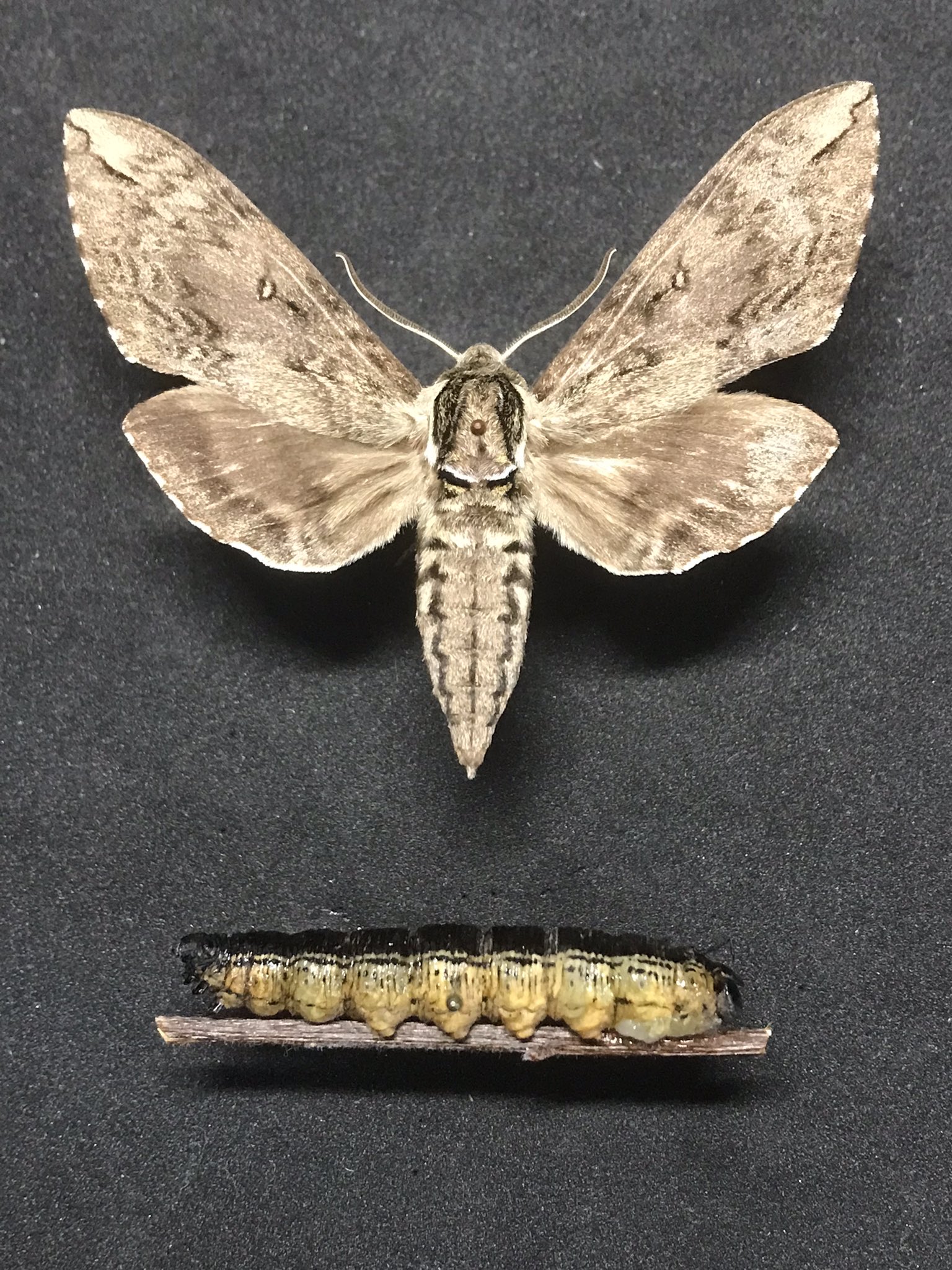

Dive into the fascinating world of insects! Explore my blog, Instagram, and website. Don't miss our newsletter and the latest from butterfly adventures!
- EdTomologist
- Junior Member

- Reactions:
- Posts: 67
- Joined: Wed May 17, 2023 5:29 pm
- Contact:

Re: Caterpillar Chronicles: Unveiling the Art of Preserving Lepidopteran Larvae
Apologies for the sideways picture—just tilt your head, folks! The Promethea Moth. Oh green, what a challenging color to preserve! To maintain its stunning translucence, silicone works wonders. I even dye my silicone to match the larva's color. I've been experimenting with resin additive glass spheres in the silicone for an opaque effect, but alas, it doesn't flow smoothly through the syringe. Any ideas, fellow enthusiasts?
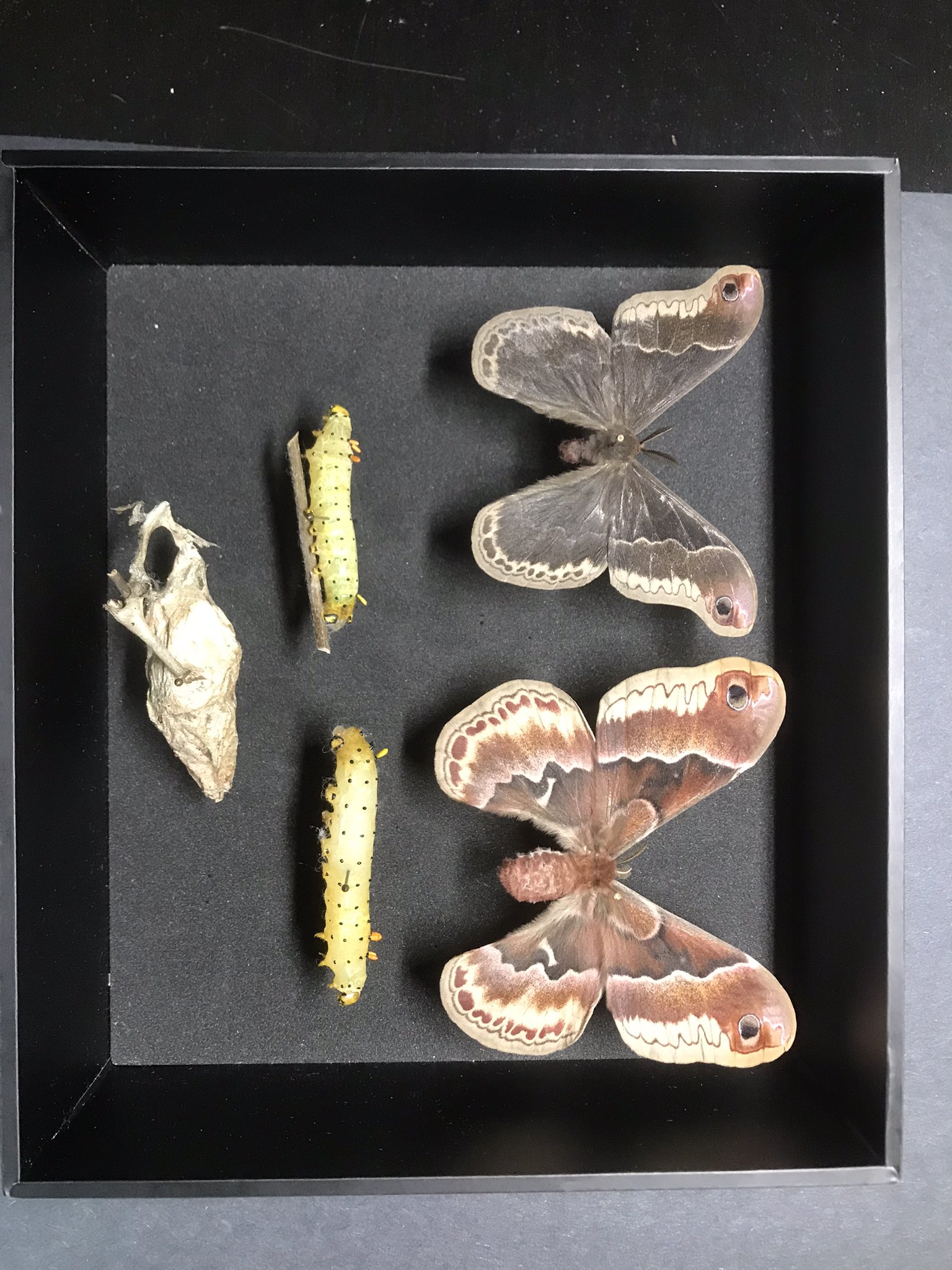
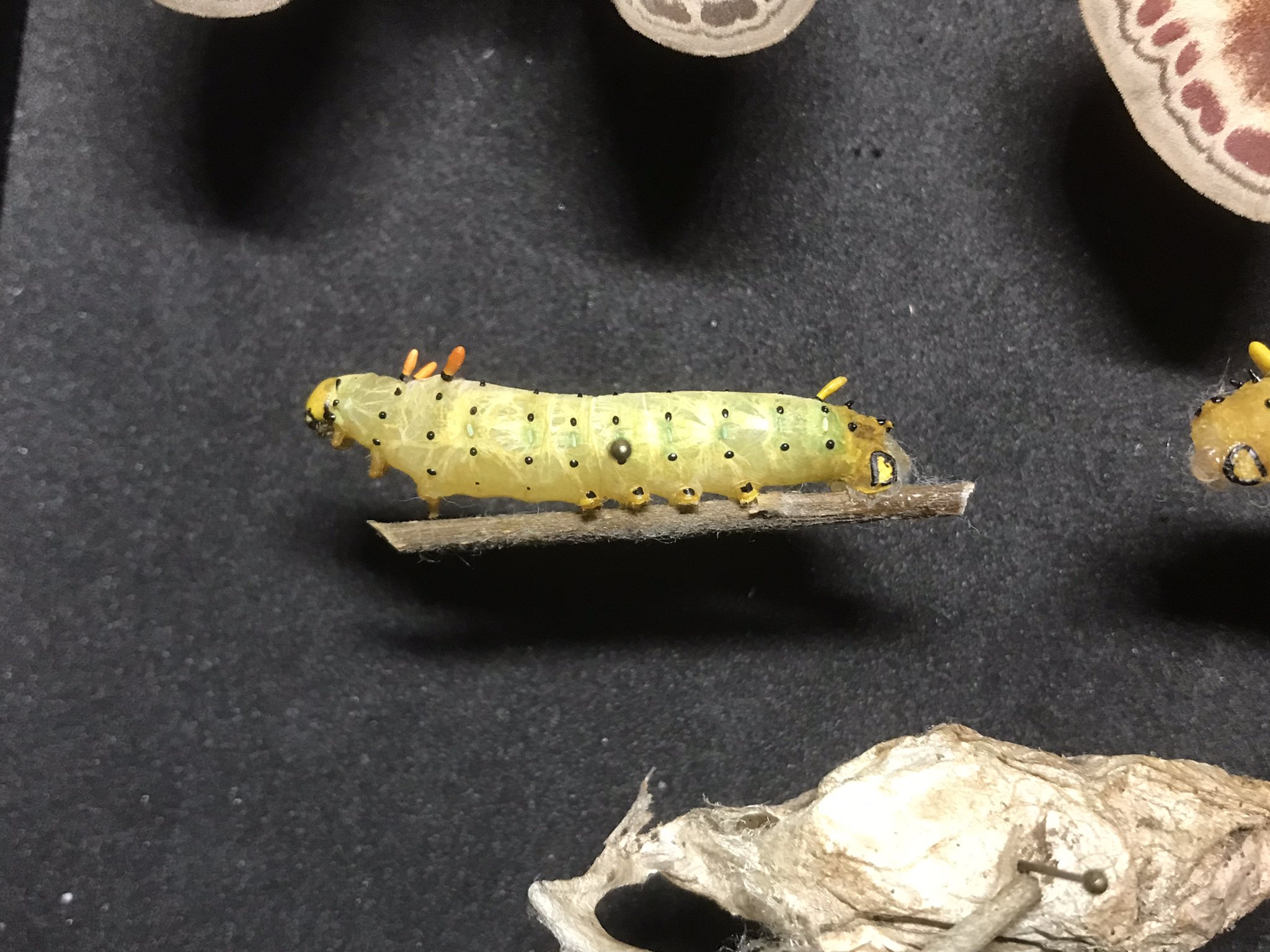
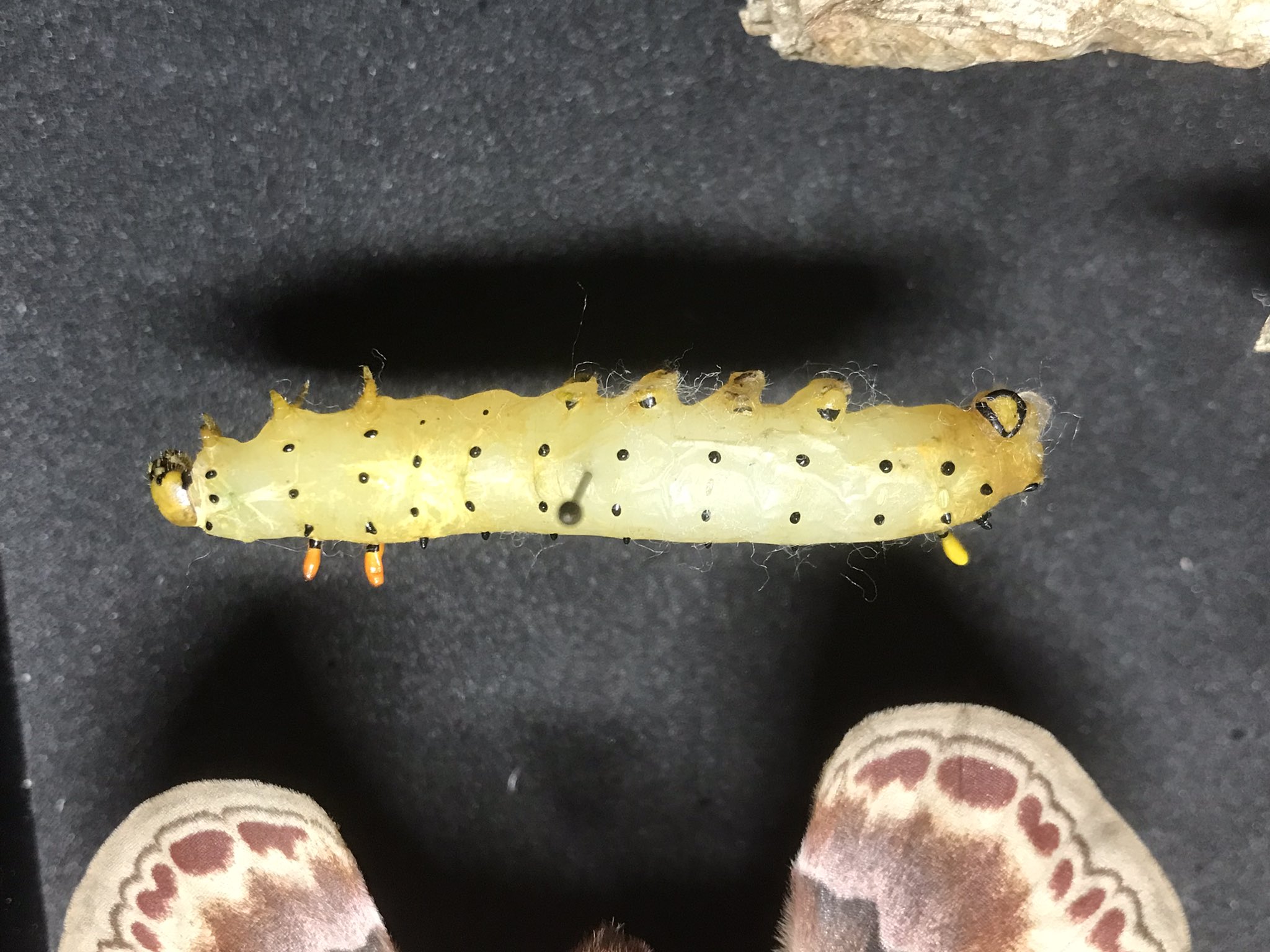
Pls ignore the little hairs you see on the larvae. I had them stored in a cotton padded box and didn't realize how tricky getting the hairs off would be.



Pls ignore the little hairs you see on the larvae. I had them stored in a cotton padded box and didn't realize how tricky getting the hairs off would be.
Dive into the fascinating world of insects! Explore my blog, Instagram, and website. Don't miss our newsletter and the latest from butterfly adventures!
- EdTomologist
- Junior Member

- Reactions:
- Posts: 67
- Joined: Wed May 17, 2023 5:29 pm
- Contact:

Re: Caterpillar Chronicles: Unveiling the Art of Preserving Lepidopteran Larvae
Eacles Imperialis Moth! Caught the female last summer she laid me some eggs and I got to work. To preserve this first instar larvae, I opted for freeze drying. Now, typically, freeze drying requires specialized equipment, but I found a unique workaround. It would take ages to freeze dry a specimen in our household fridge. To do it right you need a vacuum pump to lower the atmospheric pressure and sublimate the solid ice to water vapor - thus skipping the liquid phase. Now, although I do have DIY mini freeze dryer in the works for this very purpose, this specimen was freeze dried using a different method.
Remember high school chemistry or physics class? Acetone, our trusty friend, has a lower vapor pressure than water and evaporates quickly at the same temperature (liquids boil when vapor pressure = atmospheric pressure). So, I submerged the tiny larva, still on the pine needle, in a freezing cold glass container of acetone. This rapid freezing (quicker heat conduction of liquid to liquid) preserved the larva's shape. After leaving it in the acetone for a day in the freezer for the acetone to draw out the water, the larva was transferred to an open freezer with a defrost system. In just a couple of days, the larva completely desiccated, resulting in a beautifully freeze-dried specimen. It works for larger specimens too but will take longer ofc. It does discolor green specimens. You’ve been warned…
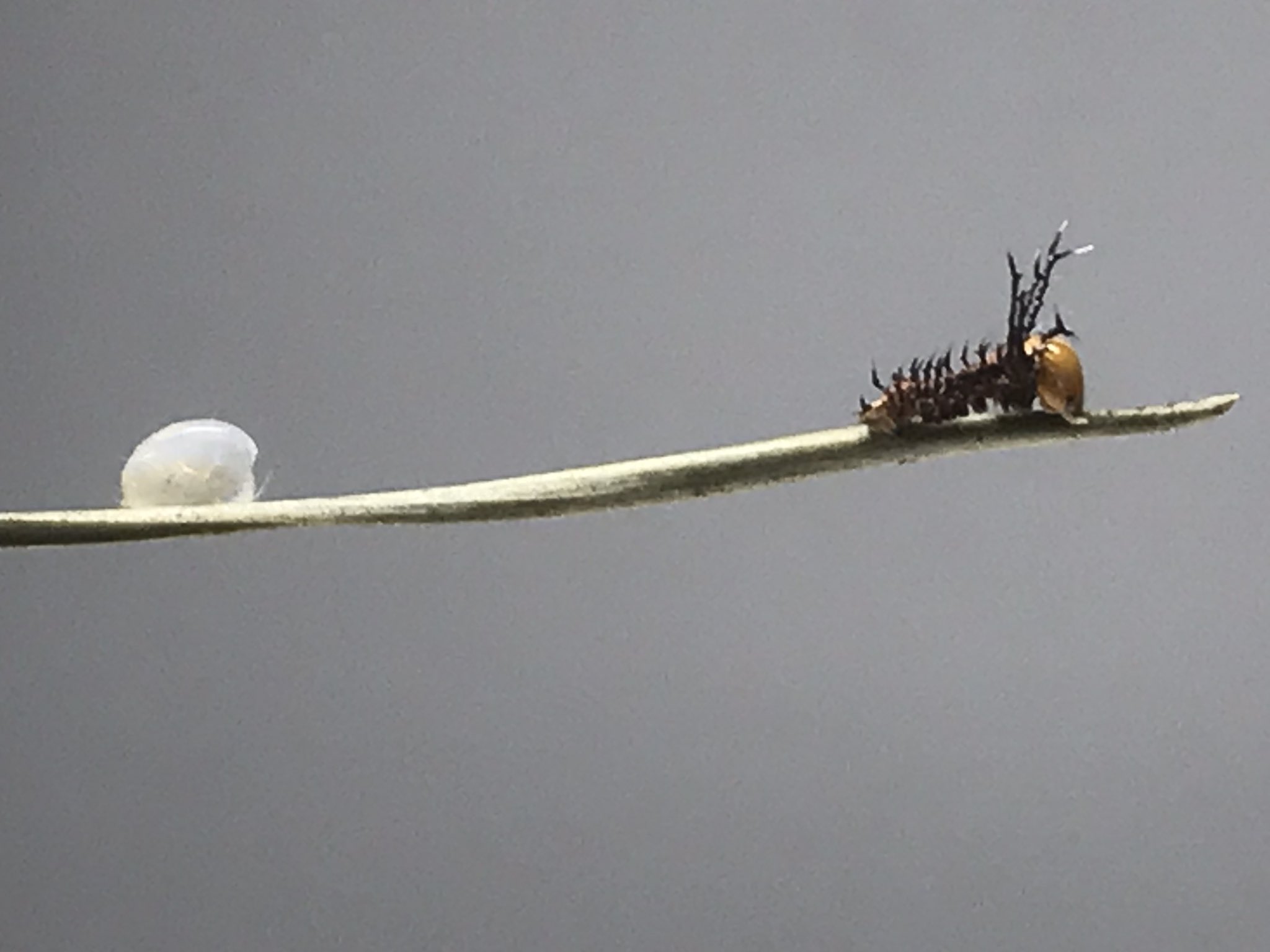
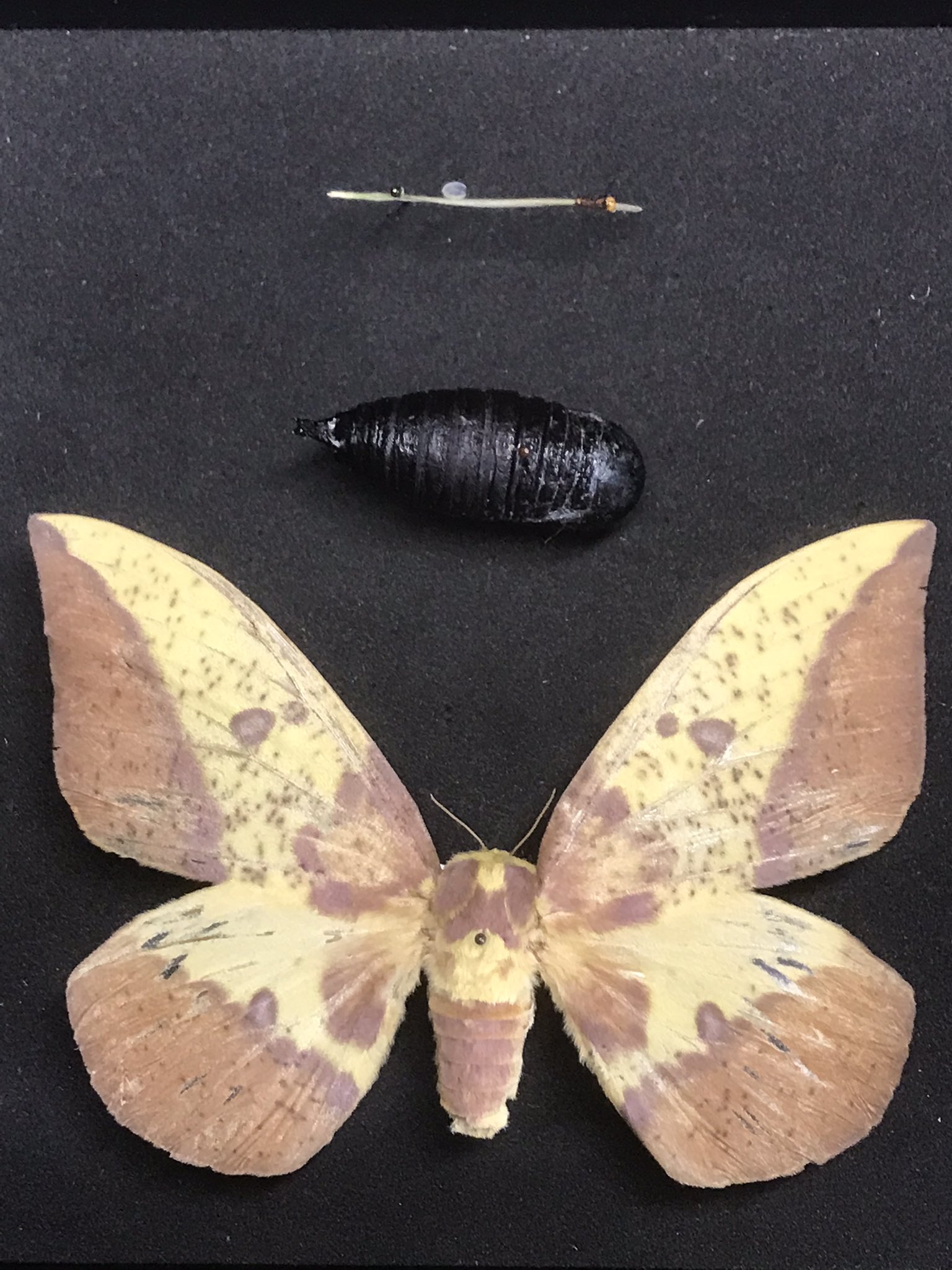
Remember high school chemistry or physics class? Acetone, our trusty friend, has a lower vapor pressure than water and evaporates quickly at the same temperature (liquids boil when vapor pressure = atmospheric pressure). So, I submerged the tiny larva, still on the pine needle, in a freezing cold glass container of acetone. This rapid freezing (quicker heat conduction of liquid to liquid) preserved the larva's shape. After leaving it in the acetone for a day in the freezer for the acetone to draw out the water, the larva was transferred to an open freezer with a defrost system. In just a couple of days, the larva completely desiccated, resulting in a beautifully freeze-dried specimen. It works for larger specimens too but will take longer ofc. It does discolor green specimens. You’ve been warned…


Dive into the fascinating world of insects! Explore my blog, Instagram, and website. Don't miss our newsletter and the latest from butterfly adventures!
- EdTomologist
- Junior Member

- Reactions:
- Posts: 67
- Joined: Wed May 17, 2023 5:29 pm
- Contact:

 Re: Caterpillar Chronicles: Unveiling the Art of Preserving Lepidopteran Larvae
Re: Caterpillar Chronicles: Unveiling the Art of Preserving Lepidopteran Larvae
Introducing the Larva Balloon Technique: A Breath of Fresh Air
Now, let's dive into the captivating world of the Larva Balloon! Here's how it works: I employ a fish tank air pump and attach an air tubing, immersing the other end in a glass of water. This setup creates pressure within the tube. But here's where the magic happens—using a pin, I carefully create a hole in the tube. But hold on, I'll elaborate on this intriguing step shortly.
Next let's explore the captivating process of Larva Inflation. First things first, ensure your larva is no longer alive, or take the necessary measures to ensure its demise. Next, grab your trusty mini rolling pin or, in a pinch, a pen will do just fine. Gently place the larva down and carefully apply pressure behind its head using the rolling pin. Take it slow and exercise caution—no incisions just yet. Observe as the posterior end of the caterpillar becomes ready to burst. At this point, take a pin and insert it into the rear end. Give it a gentle twist and pull out(important step some people forget ), ensuring that all the guts and fluids come out with it.
), ensuring that all the guts and fluids come out with it.
Now, it's time to clean out any remaining traces of innards. Locate a suitable tube for the next step. Personally, I prefer glass capillaries, but regular hypodermic needles work in a pinch. Secure the tube at the rear end of the larva, ensuring an airtight seal. Super glue is my go-to for this task. Now, take that glass capillary and insert it into the previously created hole in the tube. Switch on the air pump, and witness as the larva's skin gradually inflates. The pressure should be sufficient to maintain inflation without causing the skin to burst. If inflation isn't occurring, try using a deeper container for the water end of your airline. Alternatively, raise the tube end if the pressure is too intense.
Now, exercise patience and wait for the desired result. However, if impatience gets the best of you, there's a riskier option. You can attempt to dry the specimen using a flame but be cautious as too much fire results in bald caterpillars (and we all want to keep as much hair as possible... on our heads and caterpillars ). This technique I only recommend for hairy larvae like those of the Arctiidae family. Other larvae may end up discolored and unsightly.
). This technique I only recommend for hairy larvae like those of the Arctiidae family. Other larvae may end up discolored and unsightly.
Below is the whole lifecycle of Apantesis phalerata tiger moths.
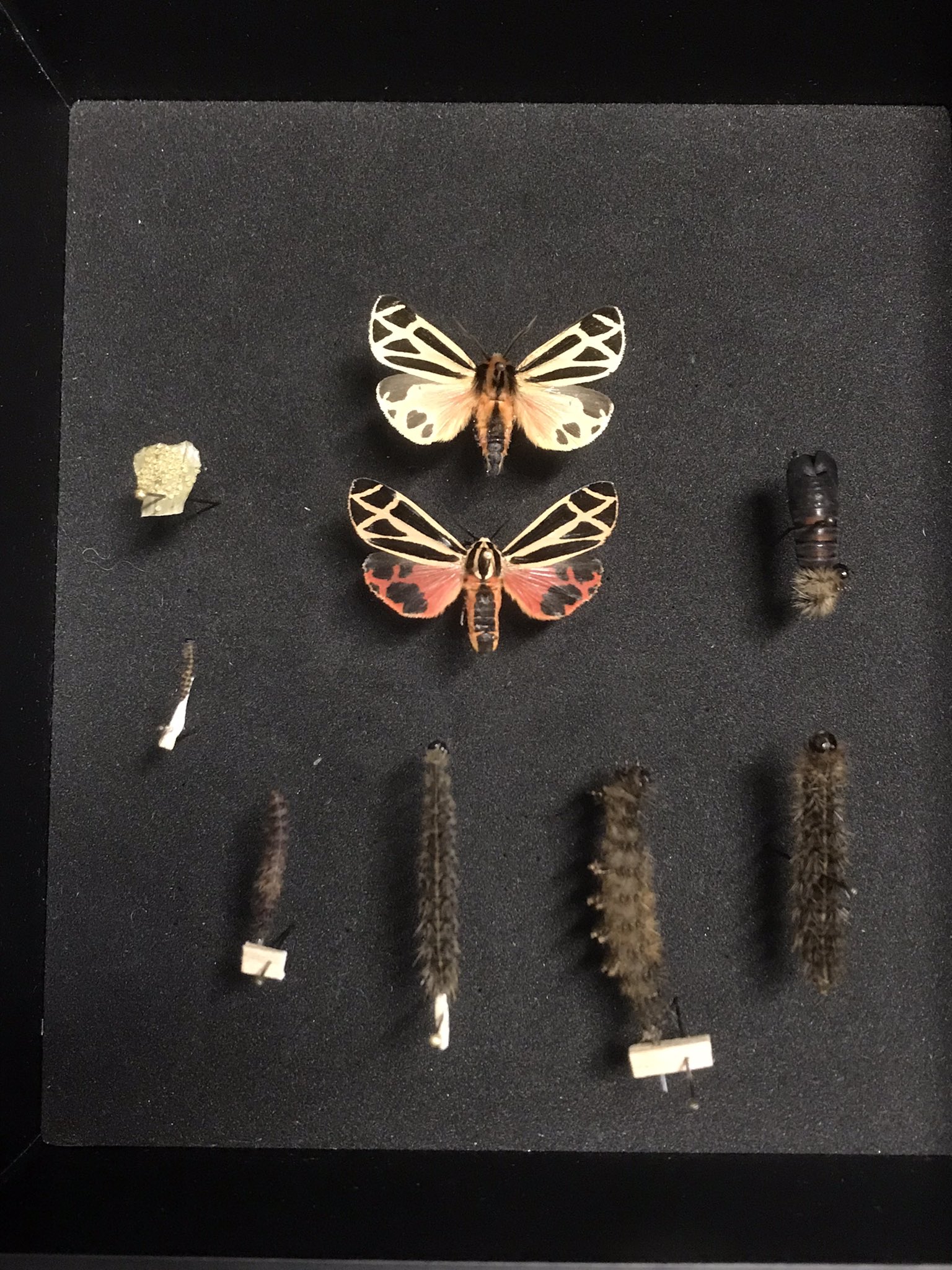
Now, let's dive into the captivating world of the Larva Balloon! Here's how it works: I employ a fish tank air pump and attach an air tubing, immersing the other end in a glass of water. This setup creates pressure within the tube. But here's where the magic happens—using a pin, I carefully create a hole in the tube. But hold on, I'll elaborate on this intriguing step shortly.
Next let's explore the captivating process of Larva Inflation. First things first, ensure your larva is no longer alive, or take the necessary measures to ensure its demise. Next, grab your trusty mini rolling pin or, in a pinch, a pen will do just fine. Gently place the larva down and carefully apply pressure behind its head using the rolling pin. Take it slow and exercise caution—no incisions just yet. Observe as the posterior end of the caterpillar becomes ready to burst. At this point, take a pin and insert it into the rear end. Give it a gentle twist and pull out(important step some people forget
Now, it's time to clean out any remaining traces of innards. Locate a suitable tube for the next step. Personally, I prefer glass capillaries, but regular hypodermic needles work in a pinch. Secure the tube at the rear end of the larva, ensuring an airtight seal. Super glue is my go-to for this task. Now, take that glass capillary and insert it into the previously created hole in the tube. Switch on the air pump, and witness as the larva's skin gradually inflates. The pressure should be sufficient to maintain inflation without causing the skin to burst. If inflation isn't occurring, try using a deeper container for the water end of your airline. Alternatively, raise the tube end if the pressure is too intense.
Now, exercise patience and wait for the desired result. However, if impatience gets the best of you, there's a riskier option. You can attempt to dry the specimen using a flame but be cautious as too much fire results in bald caterpillars (and we all want to keep as much hair as possible... on our heads and caterpillars
Below is the whole lifecycle of Apantesis phalerata tiger moths.

Dive into the fascinating world of insects! Explore my blog, Instagram, and website. Don't miss our newsletter and the latest from butterfly adventures!
- EdTomologist
- Junior Member

- Reactions:
- Posts: 67
- Joined: Wed May 17, 2023 5:29 pm
- Contact:

 Re: Caterpillar Chronicles: Unveiling the Art of Preserving Lepidopteran Larvae
Re: Caterpillar Chronicles: Unveiling the Art of Preserving Lepidopteran Larvae
And that's a wrap, folks! We've reached the end of this spectacular thread! Hopefully, it brought a smile to your face and tickled your entomological funny bone. If you thoroughly enjoyed this delightful journey, let me know and prepare for a virtual high-five! However, if this thread didn't quite hit the mark for you, well, mind your own buggy business and carry on.
Now, let's get down to business (or should I say, bugness?)! I'm dying to know your thoughts on the art of preserving caterpillars. Have you taken the plunge into this wacky and challenging endeavor? Share your tales of triumph or disaster—I'm all antennae! And if you happen to possess any invaluable insights on the matter, don't hold back! The caterpillar preservation community is buzzing with curiosity and eager to soak up your wisdom.
Now, let's get down to business (or should I say, bugness?)! I'm dying to know your thoughts on the art of preserving caterpillars. Have you taken the plunge into this wacky and challenging endeavor? Share your tales of triumph or disaster—I'm all antennae! And if you happen to possess any invaluable insights on the matter, don't hold back! The caterpillar preservation community is buzzing with curiosity and eager to soak up your wisdom.
Dive into the fascinating world of insects! Explore my blog, Instagram, and website. Don't miss our newsletter and the latest from butterfly adventures!
- kevinkk
- Premium Member - 2024

- Reactions:
- Posts: 332
- Joined: Mon May 23, 2022 5:06 pm
- Location: Oregon

Re: Caterpillar Chronicles: Unveiling the Art of Preserving Lepidopteran Larvae
It must still be early- I almost typed in "caterpillar" for my password.
In any event, I have noticed caterpillars are very colorful and interesting. Sorry though,
I have no interest in preserving them. Too much work and space required.
Years ago I read instructions for inflating larva, I'd presume alcohol would be easier, the matter
of preserving color would be the issue I'd think important.
In any event, I have noticed caterpillars are very colorful and interesting. Sorry though,
I have no interest in preserving them. Too much work and space required.
Years ago I read instructions for inflating larva, I'd presume alcohol would be easier, the matter
of preserving color would be the issue I'd think important.
Re: Caterpillar Chronicles: Unveiling the Art of Preserving Lepidopteran Larvae
Thanks for starting a dedicated topic on this. The other two times it's been discussed it was a sidebar to another topic, so I couldn't even tell you how to find them except maybe search for silicone.
I will never again use the inflation technique, silicone is far superior.
Kevin, the silicone method is easy. Cut at posterior, squish out the goo, fill with silicone, let dry 24 hours. Done.
Alcohol is the preferred method for biological research, I believe Chris Grinter cited that. However, that's not the end of the story, because alcohol loses color. In one of my projects, larval morphology is a significant contributor; while one could genetically test the larvae (and I've been waiting eight months) the rather well accepted morphology comparisons can be done with silicone injected specimens.
I will never again use the inflation technique, silicone is far superior.
Kevin, the silicone method is easy. Cut at posterior, squish out the goo, fill with silicone, let dry 24 hours. Done.
Alcohol is the preferred method for biological research, I believe Chris Grinter cited that. However, that's not the end of the story, because alcohol loses color. In one of my projects, larval morphology is a significant contributor; while one could genetically test the larvae (and I've been waiting eight months) the rather well accepted morphology comparisons can be done with silicone injected specimens.
- EdTomologist
- Junior Member

- Reactions:
- Posts: 67
- Joined: Wed May 17, 2023 5:29 pm
- Contact:

Re: Caterpillar Chronicles: Unveiling the Art of Preserving Lepidopteran Larvae
Which larvae are you preserving chuck? Swallowtail larvae? I imagine those would be tricky to preserve the color given the amount of green.
Im wanting to experiment with freeze drying and plastination. Both require a vacuum chamber which is currently in the works. The main thing left to make is a water vapor trap to keep my pump dry.
Im wanting to experiment with freeze drying and plastination. Both require a vacuum chamber which is currently in the works. The main thing left to make is a water vapor trap to keep my pump dry.
Dive into the fascinating world of insects! Explore my blog, Instagram, and website. Don't miss our newsletter and the latest from butterfly adventures!
Re: Caterpillar Chronicles: Unveiling the Art of Preserving Lepidopteran Larvae
You can see before & after photos of a Papilio larva in the Tiger Swallowtail thread.
Ward's Natural Sciences had a professional freeze dryer fifty years ago, and the results (50 years ago!) were impressive. Due to the cost I've never gone down that path.
One thing I do regret was not taking a tube of Silicone with me overseas. I never brought back any larvae (including Ornithoptera) but if I'd taken silicone I could have. Ugh. Almost worse, I have photos of a cool larva that nobody thus far has ID, but all I have is photos, I wish I'd have had silicone. So silicone would be a great way to easily and inexpensively preserve larvae in the field, including in the rot of jungles.
I wonder though, how does silicone work for larvae with fleshy tubercles? I suspect that at the least not all of them would easily be purge and refilled with silicone.
Ward's Natural Sciences had a professional freeze dryer fifty years ago, and the results (50 years ago!) were impressive. Due to the cost I've never gone down that path.
One thing I do regret was not taking a tube of Silicone with me overseas. I never brought back any larvae (including Ornithoptera) but if I'd taken silicone I could have. Ugh. Almost worse, I have photos of a cool larva that nobody thus far has ID, but all I have is photos, I wish I'd have had silicone. So silicone would be a great way to easily and inexpensively preserve larvae in the field, including in the rot of jungles.
I wonder though, how does silicone work for larvae with fleshy tubercles? I suspect that at the least not all of them would easily be purge and refilled with silicone.
Create an account or sign in to join the discussion
You need to be a member in order to post a reply
Create an account
Not a member? register to join our community
Members can start their own topics & subscribe to topics
It’s free and only takes a minute

